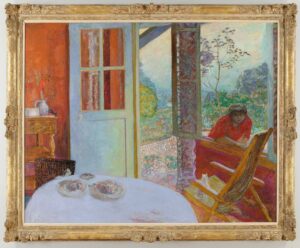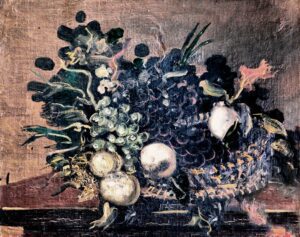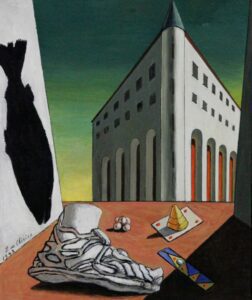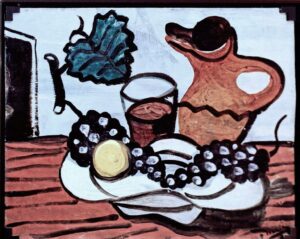Les Nabis were a trailblazing group of post-impressionist visionaries, channeling their creative energies to revolutionize the art scene in 1890s Paris.
We’ll uncover how their avant-garde approach went beyond the canvas, influencing graphic art, theater sets, and even furniture design.
With their bold colors and mystical themes, they paved the way for modern art movements, and we’re here to jump into their lasting impact on the art world.
Stay with us as we explore the intriguing realm of Les Nabis and their unique contribution to the narrative of art history.
Background Of Les Nabis
The inception of Les Nabis was rooted in a rebellion.
During the late 19th century, a young group of artists rejected the realist norms propagated by the Académie des Beaux-Arts.
They convened at the Académie Julian, and under the tutelage of Paul Sérusier, were inspired by his encounter with Paul Gauguin in Pont-Aven.
This pivotal moment gave rise to a philosophy that art was not a mere imitation of nature but an emotive expression through bold, symbolic representations.
Embracing spiritual and esoteric elements, Les Nabis believed each work should reflect the soul of the artist.
Aesthetics were
Our studies as art history enthusiasts illuminate how the movement’s name itself, derived from the Hebrew word for ‘prophet’ signifies their aim to transcend traditional art practices.
Prominent figures within this artistic brotherhood included:
- Pierre Bonnard,
- Édouard Vuillard,
- Maurice Denis,
- Félix Vallotton.
The artistic reach of Les Nabis extended into various cultural domains.
They were heavily influenced by the decorative arts and developed an interest in integrating art into daily life.
By designing furniture, theater sets, and even typefaces, they infused artistry into the mundane.
Stylistically, their graphics and illustrations displayed an affinity for Japanese prints, which was reflective of the period’s Japonism trend.
These pursuits paved a path for future art movements such as Art Nouveau, which further blurred the lines between fine and applied arts.
Delving into Les Nabis’ artistic methodologies, it’s fascinating to observe their impact on the burgeoning world of cinema.
They adopted novel perspectives and framing techniques, much like a film director choreographs a scene.
This foresight sowed seeds for visual storytelling and the subsequent tableau shot in filmmaking.
Our analysis as film enthusiasts recognizes their contribution as precursors to the visual language that’s now fundamental in cinema.
The Members Of Les Nabis
Les Nabis comprised a core group of notable artists who each brought a unique perspective to the movement.
The most prominent members included Pierre Bonnard, Édouard Vuillard, and Maurice Denis, artists who are often celebrated for their inventive use of color and form.
Each member of Les Nabis pursued individual artistic paths yet shared common philosophies About the synthesis of art and life.
Bonnard, for example, is renowned for his vibrant scenes of daily life while Vuillard tended to focus on intimate interior spaces, often blurring the lines between the occupants and their surroundings.
Other influential figures within Les Nabis included:

- Paul Sérusier – whose work The Talisman became a symbol of the group’s ethos,
- Paul Ranson – noted for his mystical and esoteric elements,
- Ker-Xavier Roussel – who found inspiration in nature and classical themes,
- Félix Vallotton – acclaimed for his woodcuts and satirical tones,
- Georges Lacombe – recognized for his sculptural work and bold use of color.
Their collective impact led to an exploration of mediums beyond traditional painting.
For instance, Denis’ experimentation with theater sets carved out new avenues for storytelling, impacting the realm of scenography.
Advancements made by Les Nabis in visual arts laid the foundation for cinematic techniques used by filmmakers.
Their emphasis on framing and composition has influenced film directors in crafting visually compelling narratives.
So, Les Nabis’ legacy extends beyond the easel, pervading the broader landscape of arts and culture.
Les Nabis’ Artistic Style
In delving into the heart of Les Nabis’ aesthetic language, we notice a distinctive blend of form and content that transcends mere visual representation.
This circle of artists embraced a stylistic approach that was radical for its time, characterized by flat areas of bold color and a departure from perspective that traditional art held sacrosanct.
Their paintings often carried a mystical vibe, achieved through the synthesis of form, pattern, and symbol.
Les Nabis were pioneers in harmonizing visual rhythm and narrative depth.
Their canvases were not just a feast for the eyes but also a journey into the artists’ minds.
Key elements that marked their style include:
- Simplified shapes,
- Intense colors,
- Strong outlines,
- An emphasis on decorative patterns.
Paintings by Les Nabis don’t merely depict scenes – they evoke emotions.
Maurice Denis’s April and Édouard Vuillard’s The Green Interior exemplify the movement’s quintessential goals, merging interior emotionality with external visuals.
Though varied in individual expression, the members were united in their quest to infuse their art with a sense of spiritual significance.
As we analyze their approach to subject matter, it becomes evident that Les Nabis had a holistic conception of the role of art in life.
They were not content with creating standalone pieces meant only for gallery walls.
Their vision extended to comprehensive art forms, including theatrical sets, book illustrations, and textiles.
Every creation was part of a greater aesthetic philosophy – art was to infiltrate and elevate the everyday.
Our appreciation of Les Nabis’ artistic style isn’t just about recalling a fascinating chapter in art history.
It’s about recognizing their role in shaping the way we experience visual storytelling, particularly in film.
They taught us that the real power of an image lies in its capacity to stir the soul, not just in its ability to mirror reality.
Influence On Graphic Art
The visual narrative crafted by Les Nabis significantly impacted graphic art, introducing a language of expression that relied heavily on form and color.
These artists effectively translated their philosophic concepts into graphic design, influencing poster art, book covers, and illustrations.

They championed the idea that graphic art was not just a tool for commercial communication but also a medium for personal expression.
As purveyors of symbolism, they laid the groundwork for modern graphic design principles.
Their approach to composition, with its emphasis on flat planes of color and the absence of perspective, is evident in the work of many graphic artists who followed.
The Nabis inspired graphic designers to pursue a more expressive path, which was less about literal representation and more about evoking a specific feeling or atmosphere.
Some key elements the Nabis introduced to graphic art include:
- Use of bold lines and flat applications of color,
- Abstraction in the service of emotional and spiritual representation,
- Integration of text and image in a holistic design.
Their influence further encouraged an ornamental quality in graphic art, with fluid lines and patterns that became hallmarks of the Art Nouveau movement.
In fact, certain members of the group, such as Maurice Denis, were directly involved in creating graphic designs that stood at the confluence of fine art and applied art, an intersection that is prevalent in today’s creative industries.
eventually, Les Nabis’s vision broadened the horizons of what graphic art could achieve.
They infused the graphic arts with a depth of narrative and a fusion of aesthetics and function, heralding a new era where designers are storytellers, and every piece of work has the potential to be a piece of art.
This legacy persists, ensuring that contemporary graphic artists are not just seen as artisans but as essential contributors to the cultural discourse.
Les Nabis And Theater Sets
Revolutionizing visual arts was just a facet of the Les Nabis’ grand vision.
They also ventured into the theatrical world, bringing their distinctive style to theater sets and costumes.
The intricate designs created by Les Nabis artists for these theatrical productions were characterized by the same bold forms and symbolic colors found in their canvas work.
By designing stage sets, the Les Nabis artists breathed new life into performances, enhancing the emotional resonance and aesthetic appeal.
Audiences were transported into stylized worlds that mirrored the Nabis’ artistic principles – where the line between art and life blurred seamlessly.
- Integrating visual arts and theater – Emphasis on symbolism and aesthetics – Collaboration between artists and playwrights.
The Les Nabis’ influence extended into the realm of performance art, shedding light on how space and visual narrative can shape an audience’s experience.
These designs weren’t mere backdrops but a dialogue between actors and the space around them, showcasing how the environment is integral to storytelling.
Collaborations with playwrights brought forth a synergy between the literary and the visual.
Members like Édouard Vuillard worked closely with avant-garde theater groups, adopting the role of scenographer with the same fervor and innovation they applied to their easel paintings.

- Scenography as an extension of painting – Engagement with avant-garde theater – Stylized environments complementing narratives.
The theater became another canvas for the Les Nabis, an opportunity to experiment and challenge existing norms.
Theater goers were not merely spectators but participants in an artistic vision that was both immersive and transformative.
This movement toward immersive storytelling has echoes in contemporary film, where directors strive for an environment that captivates and transports the viewer.
Les Nabis’ Impact On Furniture Design
In the evolution of aesthetics, the Les Nabis held a distinct vision that transcended the traditional bounds of pictorial art.
They didn’t stop at canvas – their avant-garde ideas boldly seeped into the realm of furniture design.
Their pieces stand out as functional art that simultaneously serves practical purposes and acts as a conduit for their unique symbolist perspectives.
The Nabis’ furniture pieces are easily identifiable through their signature use of vibrant colors and abstract patterns.
Interiors became a canvas of their own, with every item from chairs to armoires enveloped in the Nabis’ transformative touch.
These works integrated seamlessly into living spaces, infusing them with the Nabis’ spirit of artistry.
- Artistic Fusion – Furniture became synonymous with artwork as the boundaries blurred between utility and aesthetics.
- Symbolic Expression – Each object was more than mere furniture; it was a symbol enriched with meaning, embodying the artist’s philosophical musings.
- Innovative Craftsmanship – Embracing new techniques, the Nabis revolutionized traditional woodworking, applying distinctive motifs and ornamental inlays.
The collaboration between the Les Nabis and their patrons was indicative of a period where the artistic influence was palpable in everyday life.
Homes of the period frequently featured bespoke furnishings, each piece a testament to the innovative force of Nabis art.
Through these creative ventures, they demonstrated how art could animate the static, bringing an element of the extraordinary to the mundanity of daily existence.
By weaving their artistic philosophy into furniture design, the Les Nabis artists made a lasting impression on the decorative arts.
Each piece not only served its function but also told a story, inviting those who encountered it to ponder the meaning behind intertwined forms and carefully chosen hues.
These artists pushed the envelope, showcasing that filmmaking, like furniture, could be both an artistic and functional Try.
Legacy Of Les Nabis
Les Nabis not only reshaped the aesthetics of their time but also sowed the seeds for future generations of artists.
Their visionary approach continues to resonate in various art forms, from the canvases we admire in museums to the way scenes are composed in modern cinema.
Their lasting impact can be clearly observed in:
- The evolution of abstract art, with subsequent artists building upon the Nabis’ departure from reality.
- The bold use of color in expressionism, a direct inheritance of the Nabis’ palette.
- The stylization prominent in modern graphic novels and animation, echoing the decorative flair championed by the group.
These artists were truly ahead of their time, grasping that narrative could stem from visual cues as much as the written word.
The subtleties of their influence are threaded through the fabric of contemporary visual storytelling.
In the realm of interior design, the echo of the Les Nabis’ ethos endures.
Designers across the world still draw upon the aesthetic principles of the Nabis when creating spaces that aim to evoke emotion and narrative, proving that this historical movement’s legacy stretches far beyond the canvas and stage.
The principles of Les Nabis were not confined to their era – they are alive in current design trends and the atmospheric staging of modern commercial spaces.
Through our exploration of Les Nabis, we’ve uncovered a world where art is not limited by medium or convention.
Their embrace of symbolism and passion for integrating art into daily living provided a blueprint for marrying functionality with artistic vision, a practice that remains at the heart of design philosophy today.
Their contribution has taught us that every object, frame, and space holds the potential to be a work of art, imbued with meaning and capable of stirring the soul.
What Is Les Nabis In Art – Wrap Up
We’ve explored the profound impact that Les Nabis had on the art world, from painting to furniture design.
Their forward-thinking approach reshaped how we perceive art’s role in society, encouraging us to find beauty and meaning in the everyday.
As we reflect on their contributions, we’re reminded that art isn’t confined to galleries—it’s woven into the fabric of our lives, influencing everything from the movies we watch to the chairs we sit on.

Their legacy endures, inspiring artists and designers to merge form with function and to tell stories through color and composition.
We carry their vision into the future, cherishing their belief in art’s power to stir the soul and transform the mundane into the extraordinary.
Frequently Asked Questions
Who Were The Les Nabis?
Les Nabis were a group of post-impressionist artists from 1890s Paris who transformed art with their symbolic and spiritual approach, stepping away from realism to express the artist’s soul.
What Does ‘les Nabis’ Mean?
The name ‘Les Nabis’ originates from the Hebrew word for ‘prophet,’ reflecting their goal to change traditional art forms profoundly.
How Did The Les Nabis Influence The Decorative Arts?
The Les Nabis integrated art into daily life by designing furniture and other practical forms with bold, artistic expressions, enhancing the ornamental qualities of Art Nouveau.
What Is The Connection Between Les Nabis And Cinema?
Les Nabis adopted novel perspectives and framing techniques in their artwork that foreshadowed the visual language of modern cinema, particularly in framing and composition.
Can You Name Some Prominent Members Of Les Nabis?
Key members of Les Nabis included Pierre Bonnard, Édouard Vuillard, and Maurice Denis, among others, each contributing unique artistry to the movement.
What Impact Did Les Nabis Have On Graphic Art?
Les Nabis introduced expressive elements to graphic art, focusing on form and color, and influenced the emotive and ornamental aspects of graphic design, seen in Art Nouveau.
In What Way Did Les Nabis Venture Into The Theatrical World?
Les Nabis brought their avant-garde style to theater set and costume design, enhancing the visual and emotional experience of performances with their symbolic and bold artistry.
How Did Les Nabis Reinterpret Furniture Design?
They crafted furniture with vibrant colors and abstract patterns, integrating their forward-thinking art into everyday utility, influencing the future of decorative arts.
What Is The Legacy Of Les Nabis In Contemporary Art?
Les Nabis have influenced various art forms, including abstract art, expressionism, graphic novels, animation, and interior design, with an enduring principle of embedding narrative and emotion into design.


